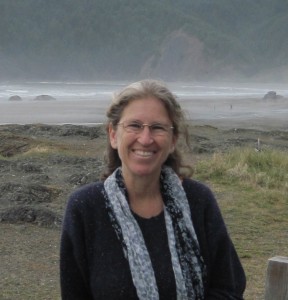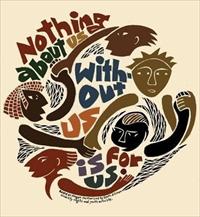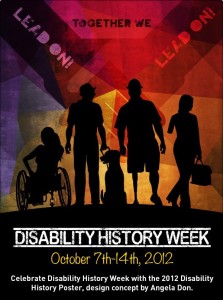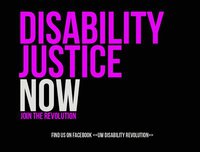Where Are the Elders with Autism? Reflections Upon Reading Fred Pelka’s What We Have Done
Rachel Cohen-Rottenberg
Union Institute & University
Fall-Winter semester, 2012-2013
Before I began reading Fred Pelka’s What We Have Done: An Oral History of the Disability Rights Movement, I’d expected that, in order to keep myself from drowning in dry historical detail, I’d have to pick and choose my way through its 600-plus pages. I was pleasantly surprised, then, to find myself reading the book into the wee hours of the morning as though it were a novel. What We Have Done combines an exhaustive rendering of historical events — the who, why, what, when, where, and how of the disability rights movement — with first-person accounts by the people who played leading roles in it. An independent scholar and the author of The ABC-CLIO Guide to the Disability Rights Movement, Pelka artfully weaves the voices of disabled activists through his historical narrative, giving form to the principle that underlies the disability rights movement: Nothing about us, without us. The result is a work that covers the framing of disability as a civil rights issue from the founding of the National Federation for the Blind (NFB) and the American Federation of the Physically Handicapped (AFPH) in 1940 through the passage of the Americans with Disabilities Act (ADA) in 1990.
For me, the most compelling material in Pelka’s book concerns the institutionalization of disabled people. I have a personal interest in this subject: my great-aunt Sarah, who was autistic and had cerebral palsy, was incarcerated in Massachusetts state institutions for most of her short life and died of tuberculosis in the Foxborough State Hospital in 1934, at the age of 25. Placed in institutional care at the age of eight, Sarah was forgotten for generations until I discovered her on a census form 75 years after her death (Disability and Representation 2012). I now have a passion for bringing the conditions of her life out of the shadows and honoring her as an autistic and disabled person. I am always shocked, then, to hear people say that autism is an entirely new condition that didn’t exist in past generations. When I hear such things, I feel as though my great-aunt has been relegated to obscurity a second time.
In reading Pelka’s book, though, I found a wealth of historical information that helps to explain exactly why autistic people like my great-aunt Sarah were invisible in their day and why their lives are still invisible now. Central to our cultural forgetting was the eugenicist argument that disabled people were a physical and moral threat to society; this belief resulted in their segregation and institutionalization. One of the reasons that institutionalization became the only option for many was that, until 1975, disabled children did not have a legally protected right to attend the public schools. Thus, many of them were placed into institutions in which abuse, squalor, and disease made their already vulnerable lives all the more fragile, and from which few emerged, except in death.
One of the people who has been most vocal about the purported impossibility of autistic people existing in large numbers before the current generation is Anne Dachel, media editor for the organization Age of Autism. Along with her colleagues, Ms. Dachel believes autism to be a recent “epidemic” caused by vaccination (Age of Autism 2012). She claims that because one doesn’t find a great many elders with autism in our nursing homes, autism as we now know it did not exist in past generations. In a blog post this past July, Ms. Dachel challenges us to explain where all the autistic elders are:
PLEASE SHOW US THE MISDIAGNOSED, UNDIAGNOSED 40, 60, and 80 YEARS OLDS WITH AUTISM. I don’t mean ones with what could be termed high functioning or Asperger’s. I don’t mean autistic adults like the ones they supposedly found in Great Britain who were able to answer survey questions. I want to see the people in our nursing homes and institutions who display the same signs of classic autism that we see in so many of our children. I want to see adults who are non-verbal, in diapers, and flapping their hands endlessly. I want to see autistic adults who’ve endured years of the seizures, sleep disorders, bowel disease and life-threatening allergies that so many of our autistic children have. I want to see adults whose history includes regression—adults who were born healthy and were developing normally until they suddenly and dramatically lost learned skills, started stimming and lost eye contact. This is what countless thousands of children with autism have gone through. SHOW US THESE SAME ADULTS. (Anne Dachel: Autism and the Media 2012)
Of course, the idea that someone could go to a nursing home as an elder implies that the person was once a part of a community. It is ironic, then, that Ms. Dachel is looking for people born between 1930 and 1975 — years in which disabled people, far from being integrated into their communities, were ruthlessly segregated from society, denied the right to an education, and consigned to a “disability gulag,” where they underwent enormous suffering, deprivation, and abuse (Pelka 2012, 49).
In order to understand why one doesn’t find large numbers of autistic adults in our nursing homes, one must begin by noting the degree to which disabled people were incarcerated and otherwise kept out of public view for much of the twentieth century. In the early part of the century, the eugenicist notion that disabled people were responsible for all the problems of society put disabled people in state institutions (Pelka 2012, 9). People with disabilities were considered a social evil that would destroy society just as disease would bring destroy a body (Pelka 2012, 11). They were therefore quarantined, kept away from nondisabled people, and stripped of their right to travel freely and to associate with others. As attorney Tim Cook explains:
[I]n virtually every state, in inexorable fashion, people with disabilities — especially children and youth — were declared by state lawmaking bodies to be unfitted for companionship with other children,’ a ‘blight on mankind,’ whose very presence in the community was ‘detrimental to normal’ children, and whose ‘mingling… with society’ was ‘a most baneful evil.’ Persons with severe disabilities were considered to be ‘anti-social beings’ as well as a ‘defect…[that] wounds our citizenry a thousand times more than any plague.’ In conclusion, then, ‘persons with disabilities were believed to simply not have the ‘rights and liberties of normal people.’ (Pelka 2012, 11)
Until the 1960s, when autism was finally defined as a condition distinct from psychosis and schizophrenia (Fombonne 2003, 1), autistic people like my great-aunt Sarah were misdiagnosed with mental illness. In fact, Sarah had diagnoses of both intellectual disability (she was diagnosed as a “moron”) and “dementia praecox,” the old term for schizophrenia (Disability and Representation 2012). People like her would have had no hope of escape from an institution — not into a nursing home, not into a group home, and not into a private home. As Pelka notes: “Because the consensus of ‘expert opinion’… was that people with disabilities, particularly those labeled ‘mentally retarded’ or ‘mentally ill,’ should be institutionalized, having a disability often meant lifelong imprisonment” (Pelka 2012, 48).
One of the social conditions that made institutionalization possible was a series of laws, in almost every state, that kept children with disabilities out of the public schools; such children, according to attorney Thomas K. Gilhool, were considered “uneducable and untrainable” (Pelka 2012, 139). Moreover, laws in some states even allowed school superintendents to take children out of their homes, against the will of their parents, and place them in institutions (Pelka 2012, 139). These institutions represented a powerful lobbying group that, according to Pelka, “actively impeded the development of community-based services and integrated public school education” (Pelka 2012, 49). Such a situation did not find remedy until the 1971 consent decree issued in the case of PARC v. Pennsylvania, which found that all children have a right to a free public education (Pelka 2012, 26). This court case ultimately resulted in the passage of the Education for All Handicapped Children Act of 1975, the precursor to the Individuals with Disabilities Education Act (IDEA) (Pelka 2012, 137). Thus, one did not see many children with autism in the public schools until after 1975 because, until then, they did not have a legal right to access a free public education. The only alternative for many children was institutionalization.
Once institutionalized, children lived in conditions that made it unlikely that they would ever survive to old age or leave the facility. The late Gunnar Dybwad, an attorney and, from 1957 to 1963, the executive director of the National Association for Retarded Children, had extensive knowledge of what befell disabled people in state care from the 1930s through the 1960s. In Pelka’s book, he describes the nightmarish conditions in state institutions, including the overcrowding, the stench of human feces, the unbearable levels of noise, and the food unfit to eat (Pelka 2012, 50-51). No one made an effort to separate children from adults (Pelka 2012, 51), and sexual abuse was rampant (Pelka 2012, 52). No oversight from state or federal agencies was in place (Pelka 2012, 51), resulting in situations in which “no one… was safe and secure” (Pelka 2012, 53) and in which children were “brutally beaten” (Pelka 2012, 53). Parents were not allowed into the facilities to see the living conditions of their children (Pelka 2012, 52) and had no idea of what was happening to them. For decades, health professionals countenanced the misery at these institutions, leading Dybwad to note that “it might be appropriate if [mental retardation professionals] started each annual meeting with a session where they would confess their sins. Because they all knew what was going on, and they never did anything about it” (Pelka 2012, 51).
Such conditions lasted well into the 1970s. Richard Bronston, a physician who worked at the Willowbrook State School and Hospital on Staten Island describes a situation of “[w]retchedness and suffering and insanity and inhumanity” (Pelka 2012, 180). The residents at Willowbrook, he remembers, lived in an environment in which they experienced rampant disease, serious injuries, constant noise, rashes from caustic floor cleaners, burns from falling asleep against the radiators, and amputations due to fungal infections (Pelka 2012, 176-178). Physical assault, sexual abuse, and pregnancy due to rape were common (Pelka 2012, 179). Far from having the opportunity to live to old age and graduate to nursing home care, residents at Willowbrook were “statistically more likely to be assaulted, raped, or murdered than in any other neighborhood in New York City” (Pelka 2012, 175). In fact, toward the end of his tenure, Bronston oversaw a ward with “a death rate that was nine times the death rate of the city of New York” (Pelka 2012, 179). It is unlikely that most autistic adults with the symptoms of which Ms. Dachel speaks — “seizures, sleep disorders, bowel disease and life-threatening allergies” — could survive to old age in such conditions (Anne Dachel: Autism and the Media, 2012). If Ms. Dachel would like to know where these adults are, I invite her to visit the cemeteries on the grounds of former state institutions. She will very likely find them there.
When I was a child growing up in the 1960s and 1970s, the only disabled children I knew in the public school system were diagnosed as “mildly mentally retarded.” I never knew any nonverbal autistic children. I never knew any children who used wheelchairs. I never knew any blind or deaf children, and I never knew any children with acute mental illness. These children were invisible to me not because they did not exist, but because most of them existed elsewhere, in a world apart. Some went to separate schools for disabled children, some remained at home, and many suffered in institutions. “Out of sight, out of mind” was the paradigm by which disabled people in past generations were segregated and incarcerated. Let us not forget them now.
References
Age of Autism. “A Letter from the Editor.” http://www.ageofautism.com/a-welcome-from-dan-olmste.html. Accessed November 6, 2012.
Anne Dachel: Autism and the Media. “The Boston Globe covers up autism.” http://annedachel.com/2012/07/25/the-boston-globe-covers-up-autism/. July 25, 2012. Accessed November 6, 2012.
Disability and Representation. “Reclaiming Memory: Searching for Great-Aunt Sarah.” http://www.disabilityandrepresentation.com/2012/10/30/reclaiming-memory-searching-for-great-aunt-sarah/. October 30, 2012. Accessed November 6, 2012.
Fombonne, Eric. “Modern Views of Autism.” The Canadian Journal of Psychiatry (September 2003): 1-4. http://ww1.cpa-apc.org:8080/publications/archives/cjp/2003/september/guesteditorial.asp.
Pelka, Fred. What We Have Done. Amherst, MA: University of Massachusetts Press, 2012.
© 2012 by Rachel Cohen-Rottenberg









Em
4/22/2013 | 6:07 pm Permalink
Walk into any L’Arche home around the world. You will find the adults who survived the institutions and many of them are very much like the children with classical autism that we see today. Their stories are tragic, truly awful. It’s amazing that anyone survived.
Cathy Y.
7/19/2013 | 12:24 pm Permalink
The public elementary school I attended in Boca Raton, Florida from 1971-1975 had a “special education” building for children with special needs such as Down Syndrome, etc. (I’m not sure about autism, but I would imagine so as well.) I think that all of the special needs children in that city attended that school, and they came on a separate school bus. Was that city “ahead of its time” in providing that service?
Rachel Cohen-Rottenberg
7/19/2013 | 7:56 pm Permalink
Perhaps. The public school that I went to in the 60s also had a separate ed classroom, but it was just for people with intellectual disabilities. I never saw anyone who was a wheelchair user, blind, deaf, or otherwise disabled in my school.
Lucinda
11/9/2013 | 10:24 pm Permalink
What a tremendous contribution to Autism History Month!
If I may, I’d like to contribute another possibility for the invisibility of us 50-something autistics?
I grew up in a rural setting- what I consider now to have been more-or-less Frontier Territory- in northern British Columbia. My parents resisted pressure to have me institutionalized before I was 5 yo. I was classic autistic, rocking, flapping, non-engaging and with frail health and chronic severe headaches.
The first school I attended, had one room and less than ten students in three grades, all the kids and the teacher from my road or nearby. I was accommodated and assisted by everybody, never bullied, not once and when I was feeling overwhelmed, there was the forest, right behind my house and horses across the road.
I improved in that setting and though it was mostly by chance that my family lived there, I suspect that other families besides mine, ones with similarly progressively minded parents, might have secreted their autistic children away in other out-of-the-way places too. Places where social norms and conventions were flaccid and could be circumvented.
I’m reminded of something I discovered about my father’s childhood in Saskatchewan with his Cree mother. At that time all Native children in Canada, were forcibly confined in church-run Residential Schools. My father, half-Cree, was exempt, because his mother had married a “White” man. That was the only way for a Native parents to protect their children from institutionalization and no doubt some made that choice, if they were able.
One day I’ll be in a nursing home, I suppose, and when I’m there, I’ll make sure everyone knows that I’m autistic and be counted as one when I die and Anne Dachel and all those hateful cranks at AoA can go stuff it!
Trackbacks & Pingbacks
[...] misconceptions and the general lack of knowledge about its history. For example, in her essay Where Are the Elders with Autism? Reflections Upon Reading Fred Pelka’s What We Have Done, she discusses the institutionalization of disabled people, an issue that has affected her family [...]